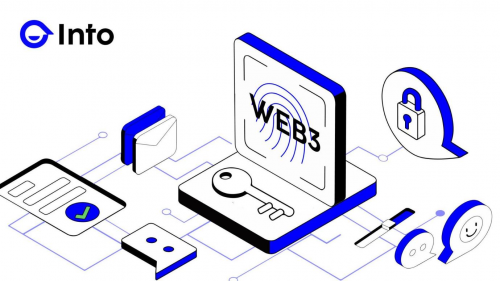The Web3 social protocol driven by blockchain technology is reshaping users perception and experience of social networks. Through the characteristics of decentralization, personalization and community autonomy, the Web3 social protocol brings users a more secure, intelligent and interesting social experience. With the continuous development of blockchain technology and artificial intelligence, the Web3 social section ecology is booming. Development, gradually becoming the fourth largest Web3 popular application after encrypted payment, DeFi and NFT.
Among them, as a world-renowned Web3 social application, INTO improves the utilization of data on the chain and expands the Web3 ecosystem by building a data layer. INTO is expected to become a standardized tool for recording and evaluating user behavior on the chain, providing important support and guarantee for the establishment of trust mechanisms and social value systems in the Web3 world.

Explore the role of on-chain credit in the Web3 world
In the Web2 world, users social reputation and value are quantitatively displayed by the platform. A bloggers number of fans, video plays, likes, and fans reflect the value of his account. However, in the current Web3 world, there is no way to quantify the behavior of users on the chain, let alone economic value. In the blockchain ecosystem of the Web3 era, the emergence of on-chain credit will pave the way for the exploration of on-chain behavior records and coding. It can even encode users credit records in the real world on the chain, from on-chain to off-chain. Together, we build the user’s identity and reputation.
For example, a users on-chain address can be bound to personal education, work resume, medical files, real estate and other tokens to enrich personal labels, and even credit his consumption behavior, credit status, assets, etc. to form an on-chain version. Sesame Credit. INTO provides an innovative idea and solution for Web3 to explore reputation mechanisms.
To achieve this goal, INTO stores user data on the blockchain and achieves decentralized management of data. Users have their own private keys, have full control over their data, and can selectively grant access to other users or applications. This decentralized data storage method greatly enhances users protection of data privacy.
Moreover, INTO uses smart technology to provide a more personalized and intelligent social experience. By analyzing users social behavior, interests and hobbies and other data, intelligent algorithms can recommend more relevant and interesting content to users, improving users social participation and satisfaction. Moreover, since data is stored on the blockchain, users can more accurately grasp their data, thus avoiding problems caused by algorithm manipulation.

INTO discovers the unique value of on-chain credit
Web technology can naturally solve credit problems, but credit chaining has always been a problem. SBT (Soulbound Token) is a concept proposed by Ethereum founder Vitalik Buterin, which aims to further develop a decentralized society and regain ownership of our own identity through digitalization. Meant to improve the security of DAOs (Decentralized Autonomous Organizations) by providing a transparent and unexploitable way to track and verify real voters. SBT represents the next stage in building a decentralized society with legitimacy and trust. The emergence of INTO has expanded the application scenarios of blockchain applications, allowing more applications that require social evaluation and trust mechanisms to be launched in a decentralized environment, injecting new vitality and possibility into the development of the blockchain ecosystem. .
INTO can combine an individuals reputation with NFT to ensure its uniqueness and non-replicability, giving credibility a physical form and enhancing its credibility and sustainability. And through the mark of SBT, the users reputation can be recorded and evaluated in the form of non-transferable Token, which provides a new idea and possibility for establishing a reputation mechanism in the decentralized world, and provides users with social networking in the Web3 world. Reputation and value establish the foundation upon which behavior is recorded and evaluated.
In addition, INTO also focuses on community autonomy, that is, users jointly participate in the management and decision-making of social networks. Through the token economic model and DAO mechanism, users can participate in the governance process of social networks and jointly decide the development direction, rule formulation and resource allocation of the network. This community autonomy model enhances users sense of participation and belonging, further promoting the healthy development of social networks.
SBT means faster, more direct access to our own personal information without having to prove the authenticity of each document, pay fees or wait for long processing times. In the journey towards a decentralized society, the next step is to digitize our own personal information to regain ownership. SBT is a great way to increase personal ownership of things like credit scores, identity, education, and work experience, as well as improve the overall security and structure of a decentralized society. INTO provides technical support and infrastructure for the establishment of users social value systems in the Web3 world, allowing users social reputation and value to be quantified and displayed on the chain.

INTO aggregates data on the chain and outlines user portraits
In the current Web3 ecosystem, data analysis products and the overall paradigm are still limited to understanding users through single address data, which is no longer enough to build a rich, real data form. If we want to expand the application types of the current Web3 ecosystem and improve product experience, the key is to solve the problem of user portraits and data association.
With zero-cost account creation models prevalent across the Web3 ecosystem, and without direct limits on the number of user accounts or indirect limits through KYC, any data based on a single address cannot accurately paint a user profile. This status quo brings huge challenges to data analysis and product design, but it also provides opportunities for innovation.
First of all, to solve the problem of user portrait and data association, we need to change the traditional data analysis thinking. Traditionally, people are used to limiting user data to a single address, but in the Web3 ecosystem, user activities may be scattered among multiple addresses, and these addresses may be associated with different aspects such as the users identity, interests, and behavioral habits. Therefore, we need to be more flexible and comprehensive in collecting, integrating and analyzing data across addresses to build a more complete and accurate user profile.
Secondly, using the characteristics of blockchain technology, especially the non-tamperability and transparency of data on the chain, can help solve the problem of user portraits and data association. Through data such as transaction records and smart contract execution on the blockchain, we can have a clearer understanding of users’ activities and behaviors at different addresses, thereby building a more comprehensive and realistic user portrait. In addition, the use of encryption technology and privacy protection mechanisms can protect users personal privacy while ensuring data security and credibility.
Finally, with the help of technologies such as artificial intelligence and machine learning, the accuracy and intelligence of user portraits and data association can be further improved. By conducting deep learning and pattern recognition on a large amount of cross-address data, we can discover potential correlations and behavioral patterns between users, thereby better understanding users needs and behavioral motivations, and providing more personalized and accurate product design and services. recommendation.
In Web3, the application of user behavioral profiling can be more private, secure and personalized. INTO can use user portraits to collect user data through decentralized identity verification, and combine it with blockchain technology to ensure the security and credibility of the data. Such user portraits can be used to provide personalized advertisements. Specifically, by integrating on-chain data across protocols, the dispersed data can be systematized and visualized to outline user portraits, helping Web3 protocol builders better understand users, and at the same time providing Web3 Integrate with the real world to provide data support.
Advertising delivery and settlement are realized through smart contracts while protecting user privacy. In addition, INTO can also use user portraits to provide personalized ecological application services, such as recommendation systems and social network functions based on user interests and behavioral habits, thereby enhancing user experience and ecological closed loop.
All in all, on-chain credit, as a new type of digital asset, plays an important value and role in the Web3 world, provides new ideas and solutions for the exploration and establishment of reputation mechanisms, and promotes the development of the blockchain ecosystem. and perfection. The emergence of INTO will also solve the problem of user portraits and data association, better understand and serve users, promote the healthy development and innovative applications of the Web3 ecosystem, and lay the foundation for building a more open, transparent and trusting online space.









